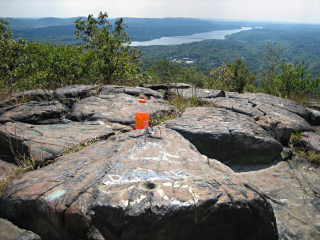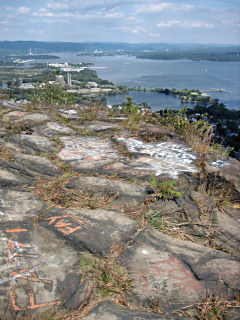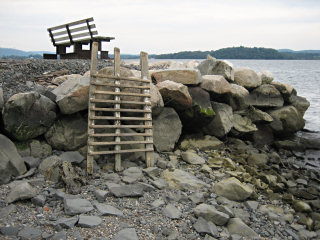Rich and I were excited to explore High Tor State Park today, not only for the chance to hike in a new and scenic area, but also for the possibility of finding some old tri-stations, or at least satisfying our curiosity regarding the datasheet description of the High Tor Beacon.
The beacon and HIGH TOR RESET (LX4218) are intriguing marks with intertwining and equally confusing histories. What is actually referred to by the PID LX4218? Is it the tower, as indicated in the 1932 monumentation note? Or the Army Corps of Engineers map control station mentioned in the 1964 recovery? It seems these points should have required two separate PIDs, or at the very least a note indicating that the map control station was set directly beneath the center of the tower. We can’t even discern from the datasheet whether the disk truly was set at the center point of the tower; if not, a new record for the map control station definitely would be required.
The datasheet for LX4218 has little to add, except that the map control disk mysteriously appeared at some point between 1938 and 1964. Unfortunately, this time even seeing the site firsthand did little to clear up the confusion.
The Long Path traverses this state park, and it leads to the top of the Tor. We began our hike at Old Route 304. It was a steep hike in spots, but short. We soon popped out of the woods and onto an expansive ledge. After just a few minutes of searching, we were able to locate the steel tower footings from the old airway beacon, as well as a squared-off chunk of brass (very likely a broken or cut disk) cemented in bedrock near the center of the square formed by the beacon footings. It is our hypothesis, as well as that of an NGS contributor from 2005, that this piece of brass is what remains of the Army Corps map control station.
Like LX4216 just a meter away, HIGH TOR RESET has a long and fascinating history. Similar to most of these old tri-stations, it began as a simple drill hole in bedrock, marked decades later by a disk and surrounded by reference marks. The disk no longer exists, but plenty of evidence still at the site (as well as our GPS coordinates) have us almost certain we have identified the point at which it was set.
Perhaps most historically interesting are the sets of drill holes found nearby. Although the datasheet is not entirely clear, it appears as though there were two sets of four drill holes surrounding the station, an inner and an outer set, and that the station hole was located at the intersection of the lines between the inner drill holes. Drill holes were evident all over the bedrock atop High Tor, and though we cannot be certain, we were able to identify likely candidates for the inner and outer sets referred to in the description. Reference mark 1 was set into one of the inner drill holes, while reference mark 2 was set into one of the outer holes, according to the datasheet. This made us more confident of our identification.
The point where we think the station was located is also at the correct distance and direction from both reference marks (whose locations we were able to identify, though neither disk still exists), the steel & concrete footings from the beacon tower, and the mysterious squared-off bolt which we think is the broken remains of the map control disk referred to in LX4216. As an additional set of measurements, we found the station point to be approximately 11 feet south of the NE footing, 11 feet 10 inches SSE of the NW footing, and 12 inches SSE of a line between the centers of the SW and SE footings.
Reference mark 1 is entirely missing, though its impression and some cement are still visible in the bedrock. The shank remains of reference mark 2. We believe that we have found the correct location and have shown this station to be destroyed, but will allow NGS to make the final determination.
Beautiful views over the Hudson, Haverstraw and Haverstraw Bay abound up here, as do sunshine and dry breezes. It was a perfect spot to spend a few hours deciphering datasheets and searching around for clues to the real story behind these tri-stations!
We then turned our attention to another intriguing nearby station, GRASSY 2. This mark has one of the most bizarre descriptions I’ve ever encountered. First, the station is described as being set “in a large mass of concrete lying on the beach.” It seems to me that no matter how large the concrete chunk, if it’s lying on sand it’s going to shift. Next, we read that the reference marks were placed in trees. Was there any thought given to the permanence of this mark?
Without any hope of finding the remains of a tri-station of such admittedly questionable stability, I nevertheless was unable to resist searching for the marks while in the area. After hiking the Tors and documenting what remains of LX4216 and LX4218, Rich and I took a rather harrowing drive through Haverstraw to this point, where we found that a neighborhood park now exists. Enduring a chilly wind we crossed the parking lot to the rocky beach and investigated the area around the coordinates. The very spot is now occupied by a high stone jetty decorated with a bench overlooking the river, presumably to provide the parkgoers an opportunity for relaxation and reflection. It provided for us only some slight frustration. It’s possible the mass of concrete, with the mark intact, still lies beneath the jetty but we saw no evidence of this. The reference marks are long gone; there are no willow trees anywhere in the immediate area.


